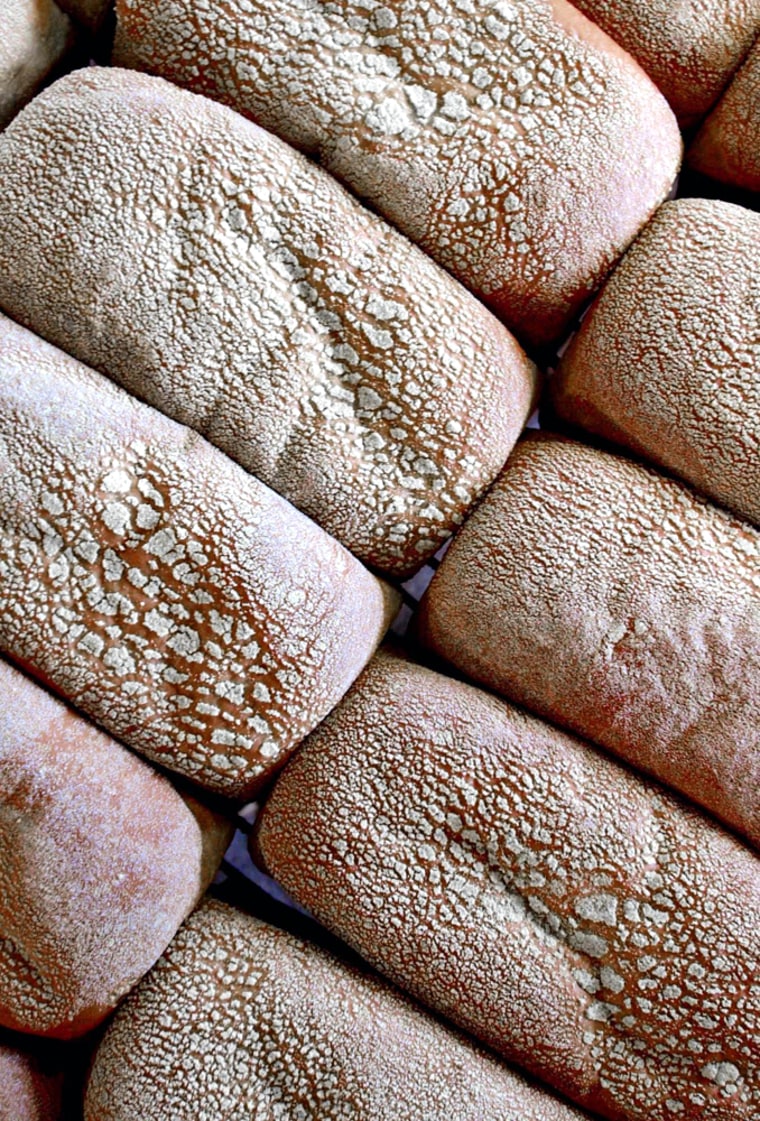Low-carb bread? That's so 2004.
The bread industry, hoping for a comeback after last year's low-carb fad, is telling consumers bread is good for them -- especially whole-grain bread.
Bread makers learned from the low-carb craze that they need to market themselves better. So, three weeks after new government guidelines calling for three one-ounce servings of whole grains a day, the industry is starting a campaign touting health benefits.
Industry officials say dietary trends are working in their favor, as low-carb peaked early last year. By year’s end, they say, sales of fresh bread in supermarkets were down by less than a percentage point in dollar terms, although volume sales were down 4 percent.
"There was an all-out assault on our industry, but people are coming back to bread and are realizing why they loved it in the first place," said Lee Schwebel of Schwebel Baking Co. in Youngstown, Ohio. "Try making a peanut butter and jelly sandwich without bread."
On Tuesday, the industry will launch a low-carb counterattack pointing to benefits of grains as part of an overall diet. The $3.5 million Grains for Life campaign will be announced in New York and Washington with billboards, posters and people dancing in bread costumes.
"The message we're trying to get out is it's the calories, not the carbs," said Lori Sachau of the Wheat Foods Council in Colorado.
Critics contend it was predictable that fickle Americans would eventually tire of the latest diet, but bread industry officials were surprised at how quickly low-carb seemed to fall out of favor. A survey by NPD Group, an independent marketing information company, found the number of American adults on any low-carb diet peaked at 9.1 percent last February and dropped to 3.6 percent by mid-November.
"The path low-carb has taken is not unlike a lot of other stuff except that it burst so fast. It went up very fast. Sometimes when things go up fast, they come down just as fast," said Stan Osman of Interstate Bakeries Corp., maker of Wonder Bread and Twinkies.
Fighting flat sales
But that's not to say the nation is about to see a bread boom. Bread sales were flat even before the obsession with the Atkins, South Beach and other carb-limiting diets, and the industry can't make up for the lost ground overnight.
While bread is still a staple for most Americans, they’re not eating it as often as they used to, causing a slow decline that has been offset only by a growing population. On average, Americans ate 136 pounds of wheat flour in 2003, a drop of 10 pounds over a four-year period, Sachau said.
In Portland, Stephen Lanzalotta opened his Italian bakery in 2000 with bread accounting for about 80 percent of sales. Business dipped in part because of low-carb diets, and bread now accounts for 20 percent of sales.
Lanzalotta stayed in business by boosting his offerings of sandwiches and pastries and expanding his menu with breakfast and Sunday brunch.
"I'm becoming more of a restaurateur than a baker. It's wearing on me. From an ideological point of view, I don't enjoy cooking as much as baking," he said.
Around the corner, the number of low-carb dieters at Anthony's Italian Kitchen has dropped, and they're drifting back to pizza, pasta and panini sandwiches. Owner Tony Barassa used to sell about 50 low-carb lunches a day; now he's lucky to sell a dozen.
Barassa said his customers tell him they got bored with Atkins-style diets, which are heavy on salads, meats, cheeses and eggs. White bread, pasta, potatoes and other carbo-loaded foods are blacklisted.
"It's something you get tired of," he said. "How many omelets can you eat?"
Across town, Big Sky Baking Co. owner Martha Elkus said she's not surprised that whole grains are winning customers.
"We've always maintained that all carbs are not created equal. Whole-grain is a complex carbohydrate. Complex carbs are the best source of energy," she said.
Overall, the shift away from low-carb is drawing people back not just to bread but to other products that took a hit, like orange juice, cereals, potatoes, bagels and pasta, said Joel Crowder of grocer Kroger Co. in Cincinnati.
Meanwhile, many consumers have given up on low-carb breads and pasta.
"There were a lot of low-carb products that were rushed to the market that didn't taste good," Crowder said. "That's probably what turned a lot of consumers off."
Sara Lee Corp. found that its cutoff for good-tasting bread was 9 carbs a slice. Anything below that just didn’t have the right taste and texture, said Matt Hall, spokesman for Sara Lee’s bakery division in St. Louis.
By year’s end, some companies were adding whole-grain products as the federal government promoted the idea of whole grains. Whole grains were also preferred by many low-carb adherents — those who couldn’t resist an occasional baked good.
Sales of premium breads and breads made with whole wheat or other grains gained are growing, while white bread sales were down 7.8 percent last year, according to Information Resources Inc. Total fresh bread sales in supermarkets were off 0.5 percent, IRI said.
But don’t count out Wonder Bread and other white breads made from enriched flour. They still account for about half of sales of fresh bread.
